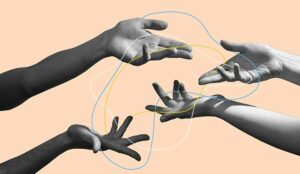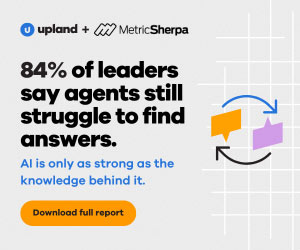Automation, AI, analytics – when so many elements in Customer Management are driven by technology, is there still a place for the human touch? Some people think that human interaction is costly or outdated when consumers are seeking the touchscreen CX they get when they hail a ride or order groceries.
At Comdata, we disagree. In fact, we know the human touch is more important than ever. However, brands may need to rethink how and when they use it, and also avoid falling prey to some common myths and misconceptions.
1. “We Can’t Afford It”
As businesses reset their budgets post-pandemic, some ask themselves if they can afford the human touch in their customer service. But rather than asking whether they can afford it, perhaps they should ask whether they can afford not to provide it. That was a point raised recently in Forbes magazine, and it certainly reflects our own thinking.
Automation and technology have certainly been game-changing in terms of convenience, speed and ‘anywhere, anytime’ access for customers, and the need to transform digitally is a no-brainer. But the human touch can also be game-changing. “More than ever, great customer experience depends on the human factor”, stated McKinsey & Co in a recent report.
In essence, the human touch can make customers feel like you care and may therefore be a crucial part of the personalized CX that consumers now seek. Used effectively, it carries the potential to accelerate resolution, reduce cost, deepen customer trust and loyalty, add retention and cross-selling opportunities, and increase revenues.
2. “Surely We Can Automate Instead?”
The response to this question is usually “Yes”. But automation may not always provide the best solution or create value.
In every customer business process – sales, customer care, technical assistance and credit management – there are likely to be channels, segments or points of the journey where automation is more cost-effective.
However, in every process, there will also be channels, segments and points of the journey where the human touch has potential to create value. The key for brands is to understand their customers: who they are, what their expectations are and what matters to them, how to meet their needs.
Or to put it another way, in which areas of your inbound or outbound sales and customer care, and in which channels could some high-quality human input help to create value?
Take the example of remote sales. We know that customer expectations and shopping habits changed during lockdown, and that brands are using technology to cater for this – from chatbots to predictive analytics to virtual fitting rooms or online car tours.
There’s some brilliant technology and creativity out there in the market. But customers sometimes want to talk to someone instead – to get advice on a household appliance or some IT equipment or some help in deciding between different items.
From our own analyses with brands, we know that conversion rates for some types of remote shopping can be significantly higher where customers get human support. Luxury goods, consumer electrical goods or high-end homeware are typical examples of this.
There’s a similar story in customer care. For many interactions, quick and convenient digital self-care will be exactly what the customer wants; for others, a human agent may be needed to resolve the issue. The right intuitive intervention can create trust, loyalty and a quicker resolution of the issue.
3. “It’s Too Complicated to Have a Mix”
The short answer is, “No, it’s not”. At least it’s not too complicated if you use Customer Management providers that can effectively design and deploy hybrid solutions. These could take different forms, such as:
- Developing tools that orchestrate a smart mix of agents and automation, using AI to determine where a human needs to step in – either to resolve or prevent a problem or to cross-sell, upsell or convert a sale to a customer identified as likely to be receptive
- ‘Bestshoring’ – offering the full spectrum from self-care through to simple human interactions through to escalations or VIP care and sales, across different geographies. This can offer scaleable and flexible solutions and high-touch care whilst also optimizing tight budgets.
- Using advanced analytics to better understand and predict customer expectations at every touchpoint, to better plan and deliver the mix of self-care and human care. This mix will be different for every brand.
In all these different elements and examples, consumers will expect the brand’s mix of channels, self-care and human solutions to integrate seamlessly. Your approach to digital transformation, technology and processes must be able to deliver that.
4. “It’s Old-Fashioned”; “You Can’t Stop the Advance of Technology”
A major misconception about the human touch is that it’s somehow ‘anti-technology’ or ‘anti-automation’. Not at all. Offering the human touch in the 2020s is all about embracing technology – using automation, AI, analytics and predictive tools to offer higher-quality human interaction and seamless customer service.
We talk a lot about our ‘augmented agents’. These are skilled, trained agents whose people skills are backed by technology and technical skills – who can use multiple tools, processes and systems to deliver tailored or gold standard customer service and offers.
These agents are the perfect example of how far from depersonalizing Customer Management, technology is being used to further personalize it, by making the human touch even more effective.
What also characterizes the augmented agent is their ability to offer high-quality personal interaction and connection, based on a mix of training, empathy, good scripting and some autonomy in what they can offer the customer.
To quote McKinsey & Co again, “When frontline employees have the proper authority to take action based on an individual customer’s attributes, needs, and situation, they can take ownership of the interaction.”
There’s another element to add in here too: culture. Employees who take pride and pleasure in their work are more likely to deliver positive experiences to customers.
In a world where customers may only speak to someone representing your brand just once a year – or even just once ever – you need agents to be personable and passionate ambassadors. After all, the human touch is only as effective as the person who delivers it.
But it’s also only as effective as the technology that person has at their fingertips, and the processes in place for them to deliver for clients. You need the best blend of people, process and technology to achieve the best results.
Author: Guest Author
Published On: 29th Oct 2021 - Last modified: 2nd Nov 2021
Read more about - Guest Blogs, Comdata





































